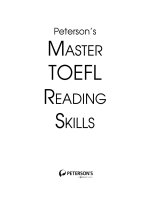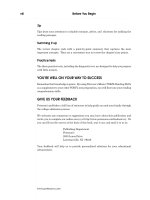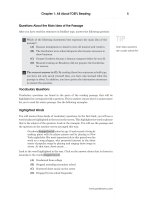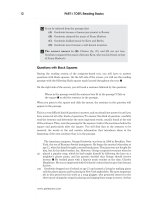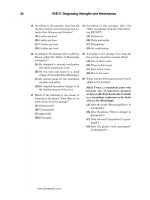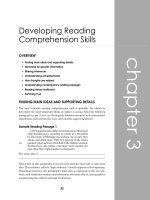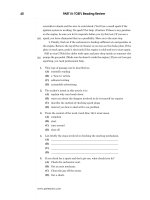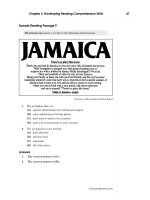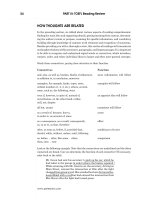Peterson’s master toefl reading skills part 30 doc
Bạn đang xem bản rút gọn của tài liệu. Xem và tải ngay bản đầy đủ của tài liệu tại đây (77.9 KB, 7 trang )
194 PART V: Appendixes
www.petersons.com
the institution (and to the agency, if one is being used). You, as the applicant, should
not mail such records to the institution. If you do, the records might not be
considered “official.”
• Academic records that are not in English need to be translated, and both the
original-language records and the translation must be sent. Pay particular atten-
tion to the instructions regarding translations. Some institutions and agencies
might allow you to do the translation yourself if you are sufficiently proficient in
English. However, others might require an official translation or one done by an
authorized or licensed translator. Follow instructions carefully to avoid unneces-
sary delays.
• Standardized tests are an important part of the application process for U.S.
institutions. If you were educated in a system that uses external national exami-
nations, such as the Baccalaureat from France or “Ordinary” or “Advanced” level
examinations from the United Kingdom, you will need to send copies of the results
of these examinations. If you are applying as a first-year student at the under-
graduate (bachelor’s degree) level, you may also need to take certain standardized
tests that are often required of U.S. applicants, such as the SAT or the ACT
Assessment. Schools will instruct you as to which test(s) to take and how to make
arrangements for testing.
• If English is not your native language, or if you have not been educated in a country
or region where English is a native language, you may be required to submit the
results of an English language proficiency test, such as the Test of English as a
Foreign Language (TOEFL).
• If you need an F-1 or M-1 (student) visa or a J-1 (exchange visitor-student) visa, you
will need to present evidence that you have adequate financial support for the
entire period of your anticipated study. Most U.S. colleges and universities will ask
you to complete a form regarding the financial support for your studies, or they will
tell you what documentation is required. Usually, you will have to complete a form
outlining the sources of your financial support as well as provide verification of such
support. Again, carefully follow all instructions regarding documentation.
• Deadlines are extremely important! Pay close attention to any deadlines listed on
the application forms. The admission of international students to U.S. institutions
does take more time than the admission of U.S. students, and most schools have an
earlier international application deadline. U.S. colleges and universities receive
thousands of applications from international students each year. In order to be
considered for admission for the term in which you want to begin your studies, it
is essential that your application and all materials be received before the deadline.
Studying in the United States will be an exciting and rewarding experience. To start off
in the best possible way, carefully follow the instructions of each institution in which you
are interested. If you have any questions about the application process or what
materials you need to provide, contact the institution for clarification or assistance.
08_TOEFLReadingAppB,177-206 7/29/06, 12:53194
Appendix B: Applying to Colleges and Universities in the U.S. 195
www.petersons.com
UNDERSTANDING ACCREDITATION
Kristine Luken Program Specialist
U.S. Department of Education
Accreditation in the United States is a voluntary, nongovernmental process in which an
institution agrees to be evaluated and/or have its programs evaluated by an accrediting
agency against standards for measuring quality. The goal of accreditation is to ensure
that the education provided by institutions of higher education meets acceptable levels
of quality.
Accrediting agencies are nongovernmental, private educational associations that carry
out the function of accrediting institutions and programs to determine their quality.
Institutions and programs that request an agency’s evaluation and meet its evaluation
criteria are then accredited by that agency.
Having a basic understanding of accreditation—what it is and what it means—will help
you to make choices that will bring you closer to meeting your career goals.
Recognized vs. Unrecognized Accrediting Agencies
Accrediting agencies fall into two categories: recognized and unrecognized. It is
important to understand the difference between the two categories.
Recognized Accrediting Agencies
The U.S. Department of Education does not accredit institutions; rather, it determines
which accrediting agencies receive recognition by the Department. Accrediting agen-
cies may voluntarily seek recognition from the Secretary of Education, but it is not a
requirement that they do so. Recognition by the Department is limited to those agencies
that accredit institutions that need the recognition in order to participate in federal
programs, such as the Federal Student Financial Aid Program. While some recognized
accrediting agencies may accredit foreign institutions, those accrediting activities are
outside the authority and review of the Department. An accrediting agency that meets
the Department’s criteria for recognition is believed to be a reliable authority on the
quality of education or training provided by the institutions it accredits in the United
States and its territories.
Accrediting agencies recognized by the Department of Education can have a regional or
national scope: regional agencies accredit degree-granting institutions within six
geographic regions of the United States, and national agencies accredit institutions or
programs all across the United States. Agencies that meet these criteria are placed on
the Department’s List of Nationally Recognized Accrediting Agencies, available at
/>08_TOEFLReadingAppB,177-206 7/29/06, 12:53195
196 PART V: Appendixes
www.petersons.com
The Council for Higher Education Accreditation (CHEA), a private, nongovernmental
agency, also recognizes organizations that accredit institutions and programs. CHEA
recognizes many types of accrediting organizations, including some of the same
accrediting agencies that the Department of Education recognizes. In order to be eligible
for CHEA recognition, accrediting organizations must demonstrate that their mission
and goals are consistent with those of CHEA and that a majority of the institutions and
programs accredited by the organization award degrees. CHEA’s List of Participating
and Recognized Organizations can be found at />Unrecognized Accrediting Agencies
Just as there are recognized accrediting agencies, there are unrecognized accrediting
agencies. Accreditation standards of unrecognized accrediting agencies have not been
reviewed by the Department of Education or CHEA. There are a variety of reasons why
an agency may be unrecognized. For example, the agency may be working toward
recognition with the Department or CHEA, or it may not meet the criteria for
recognition by either organization.
Unrecognized accrediting agencies should be viewed with caution until their reputation
can be determined. If an agency is unrecognized, this does not necessarily mean that
they do not have high standards of quality. But it is important to know that many
employers in the United States only recognize degrees earned from institutions
accredited by an accrediting agency recognized by the Department or CHEA.
For more information about recognized and unrecognized accrediting agencies, as well
as fraud and abuse related to accreditation, visit the U.S. Network for Education
Information Web site at />us/edlite-accreditation.html.
Accredited vs. Unaccredited Institutions
It is not enough to know the meaning of recognized and unrecognized accrediting
agencies; it is also important to know the difference between accredited and unaccredited
institutions.
Accredited Institutions
Accredited institutions have agreed to be reviewed and/or have their programs reviewed
to determine the quality of education and training being provided. If an institution is
accredited by an agency recognized by the Department of Education or CHEA, its
teachers, course work, facilities, equipment, and supplies are reviewed on a routine
basis to ensure that students receive a high-quality education and get what they pay for.
Attending an accredited institution is often a requirement for employment in the United
States and can be helpful if you plan to transfer academic credits to another institution,
such as graduate school.
08_TOEFLReadingAppB,177-206 7/29/06, 12:53196
Appendix B: Applying to Colleges and Universities in the U.S. 197
www.petersons.com
Any institution can claim to be accredited. It is important that you take the time to learn
about the accrediting agency and its reputation. To find out if the institution you are
interested in is accredited by an agency recognized by the Department, review the
Department’s database of postsecondary institutions and programs at http://
www.ope.ed.gov/accreditation/.
Unaccredited Institutions
Unaccredited institutions are not reviewed against a set of standards in order to
determine the quality of their education and training. This does not mean that an
unaccredited institution is of poor quality, but earning a degree from an unaccredited
institution may create problems for a student.
Some employers, institutions, and licensing boards only recognize degrees earned from
institutions accredited by an accrediting agency recognized by the Department. With
that in mind, it is recommended that a student check with other institutions regarding
their transfer-of-credit policy to determine whether they would accept the degree and/
or credits earned from any institution in which the student is considering enrolling.
In some states, it can even be illegal to use a degree from an institution that is not
accredited by an accrediting agency recognized by the Department unless approved by
the state licensing agency.
It is important to determine if a degree from an unaccredited institution will allow you
to achieve your educational and career goals. To learn more about the issues and
problems that may arise from pursuing an unaccredited degree, read over the fre-
quently asked questions developed by Degree.net at />accreditation_faqs.html.
Fake Accrediting Agencies
Fake accrediting agencies offer accreditation for a fee without doing an in-depth review
of the school’s programs or teachers. Their accreditation has nothing to do with ensuring
that students receive a high-quality education and is worthless and meaningless.
Fake accrediting agencies may adopt names that are similar to other well-known
accrediting agencies, sprinkle the names of legitimate institutions in their list of
accredited members, and even use all the right-sounding words in their marketing
materials to describe their accrediting standards and review process. These are just
some of the ways fake accrediting agencies try to confuse students and make them
believe they are legitimate.
So, do not be misled by a name or a slick marketing technique; always do your homework
on any institution you want to attend. Remember, it is not enough to know that an
institution is accredited. You also need to find out as much as you can about the
accrediting agency. Your efforts will be worth your time.
08_TOEFLReadingAppB,177-206 7/29/06, 12:53197
198 PART V: Appendixes
www.petersons.com
U.S. and Foreign Diploma Mills
A familiar definition of diploma mill is “an organization that awards degrees without
requiring students to meet educational standards for those degrees.”
Diploma mills are not accredited by a nationally recognized agency. You will not find the
institution’s accrediting agency on the Department’s list of Nationally Recognized
Accrediting Agencies or on CHEA’s List of Participating and Recognized Organizations.
Instead, diploma mills often claim accreditation by a fake accrediting agency to attract
more students to their degree programs and make themselves seem legitimate.
Remember: In some states it can be illegal to use a degree from an institution that is not
accredited by a nationally recognized accrediting agency unless approved by the state
licensing agency.
Not only are U.S. diploma mills a problem, but foreign diploma mills selling their
degrees in the United States are a problem too. Some of these foreign diploma mills even
claim to have approval from the education ministry of their country to offer degrees,
when, in reality, they are operating without the knowledge of the country. Often these
institutions use the name of the foreign education ministry in their marketing materials
to make themselves seem legitimate. What the institution is trying to do is make
students believe that its programs have been reviewed and meet some level of quality
when, in fact, they do not.
Before taking the offer to enroll in a foreign institution, find out as much as you can about
the accreditor and the institutions it accredits, as well as the recognition process of the
foreign education ministry. This information will give you a better picture of the
institution and its reputation. To review a list of agencies that license and regulate
higher education in Canada and other countries, visit www.degree.net/guides/
checking_out2.html.
The .edu Extension in Internet Addresses
Not all institutions in the United States that use the .edu extension as a part of their
Internet address are necessarily legitimate institutions. Before the Department of
Commerce created more strict requirements, some questionable institutions were
approved to use .edu in their address. New requirements allow only those institutions
accredited by an agency recognized by the Department of Education to use it. However,
institutions that were approved to use it before the new requirements were put into
place can still use it, which means there could still be some illegitimate institutions with
.edu in their address. Whether an institution uses the .edu extension or not, it is
important to know as much as possible about the institution before enrolling.
08_TOEFLReadingAppB,177-206 7/29/06, 12:53198
Appendix B: Applying to Colleges and Universities in the U.S. 199
www.petersons.com
FINANCING YOUR U.S. EDUCATION
Nancy W. Keteku
Regional Educational Advising Coordinator for Africa
Education in the United States can be expensive. However, higher education is the most
important investment you will ever make. You should start your financial planning at
the same time you select the colleges to which you will apply; that is, about one year prior
to enrollment.
Financing your college education is a four-pronged effort, consisting of
• assessing your personal and family funds;
• identifying financial assistance for which you are eligible;
• compiling effective applications; and
• reducing educational costs.
First, you need to confer with your parents and other family sponsors to find out how
much money they can commit each year to your education. Try to raise as much money
as possible from family sources, because most scholarship awards are highly competi-
tive and cover only part of the total educational and living costs.
At the same time, conduct research in your own country to find possible funding from
local government, business, or foundation sources. Although these sources are not
found in all countries, you may be able to reduce your educational cost through
scholarships from local organizations.
If your family and local funds do not cover the cost of a U.S. education, you will need to
look for financial assistance from other sources, such as American colleges and
universities. However, when searching, do not assume that all institutions award
financial aid. In fact, only about 50 percent of the institutions offering bachelor’s degrees
provide financial assistance to students who are not citizens or permanent residents of
the United States, and most of them provide only partial assistance. Keep in mind that
financial aid for U.S. students is different from financial aid for international students.
Be sure to inform the admissions office of your country of citizenship and request
information on financial aid available to non-U.S. citizens.
CAN I AFFORD COLLEGE?
You have probably heard about scholarships and financial aid. So what’s the difference?
A scholarship is a financial award based on merit in areas like academics, athletics and
performing arts, or community service and leadership. Financial aid is based on a
student’s financial need, as documented by family income, assets, and other factors.
Although different in many ways, most scholarships and financial aid are extremely
competitive and require an exemplary academic record. Consult with your educational
08_TOEFLReadingAppB,177-206 7/29/06, 12:53199
200 PART V: Appendixes
www.petersons.com
adviser on how to research available financial aid for international students. You will
discover that most financial awards cover only a portion of the total cost of attendance.
Thus, the more money you can raise from family sources, the better your chances are of
attending the college or university of your choice.
As you do your research, make a list of the colleges and universities you would like to
attend. Write down the annual cost of each (tuition, fees, insurance, room and board,
books, and clothing), and then enter the total financial aid award offered by each of the
institutions. In this way, you can quickly see where your best chances lie, and you can
eliminate the institutions where you would not stand a good chance of attending based
on the financial aid you would receive. When planning your finances, consider these
ways to reduce your costs:
• Look for institutions that offer the highest quality education at the lowest price.
• Try to complete a four-year bachelor’s degree in three years. This will save you
thousands of dollars. Students can accelerate their programs by earning transfer
credit for college-level courses completed in the home country; taking courses at a
nearby community college—if tuition is lower and credits are transferable; attend-
ing summer school; and taking one additional course each semester.
• Find out if the institution offers scholarship assistance based on your first-year
grades. A superior academic record could save you thousands of dollars.
• Live off campus with a relative or friend.
• Attend a community college for the first two years and then transfer to a four-year
institution to complete your degree.
Here are some additional pointers on financing your U.S. education:
• International students often ask about full scholarships, which cover the entire cost
of education, except for airfare. These awards are both rare and competitive. The
total number of full scholarships offered to incoming international students each
year is about 2,000, offered by only about 200 colleges in the United States. There
are usually 20 highly qualified international students competing for each major
scholarship. To compete successfully for a full scholarship, you must be one of the
top students in your country, have a high grade point average (GPA), score well on
the SAT and TOEFL, and demonstrate outstanding performance in other areas,
such as leadership.
• International students also ask about financial assistance from foundations,
organizations, and the U.S. government. These types of financial aid are rarely
awarded to international students because there is very little aid available through
such sources, and it is usually earmarked for advanced graduate students. Fewer
than 5 percent of international undergraduates are financed through these sources.
Again, your educational adviser can tell you whether or not there are special funds
available for students from your country.
08_TOEFLReadingAppB,177-206 7/29/06, 12:53200
